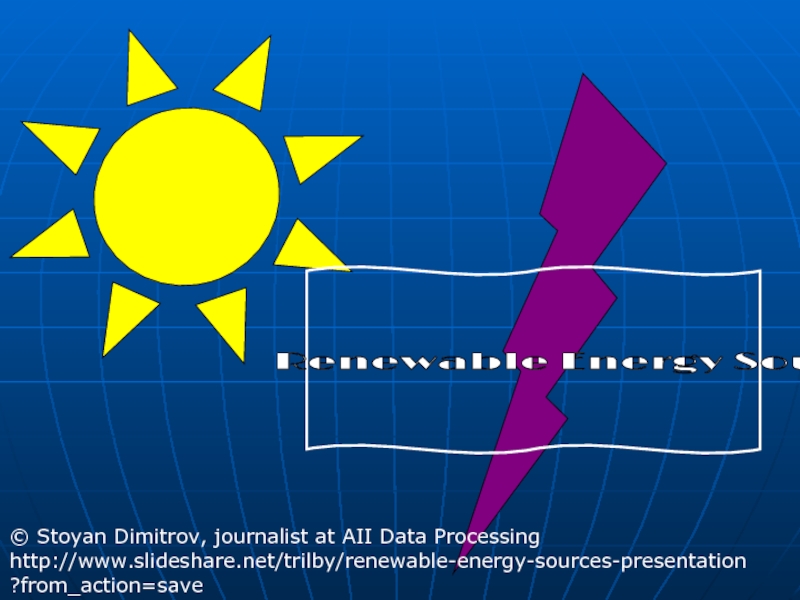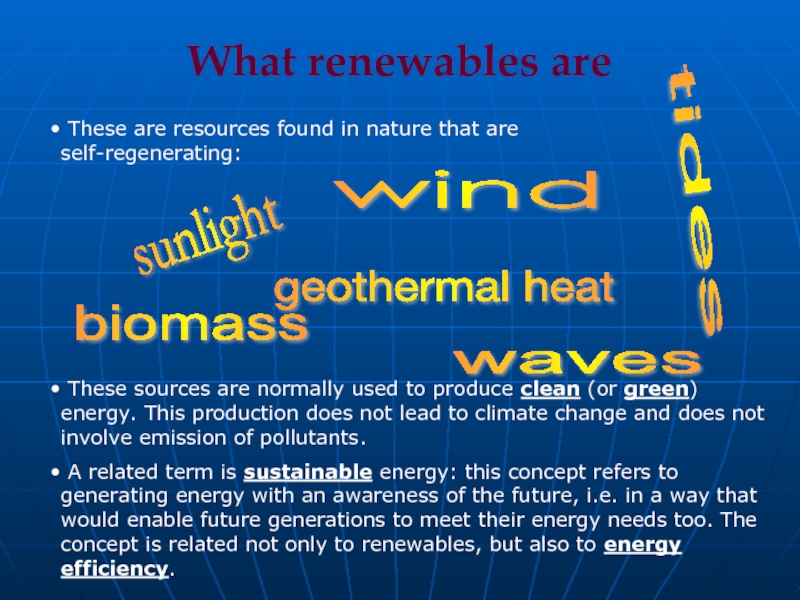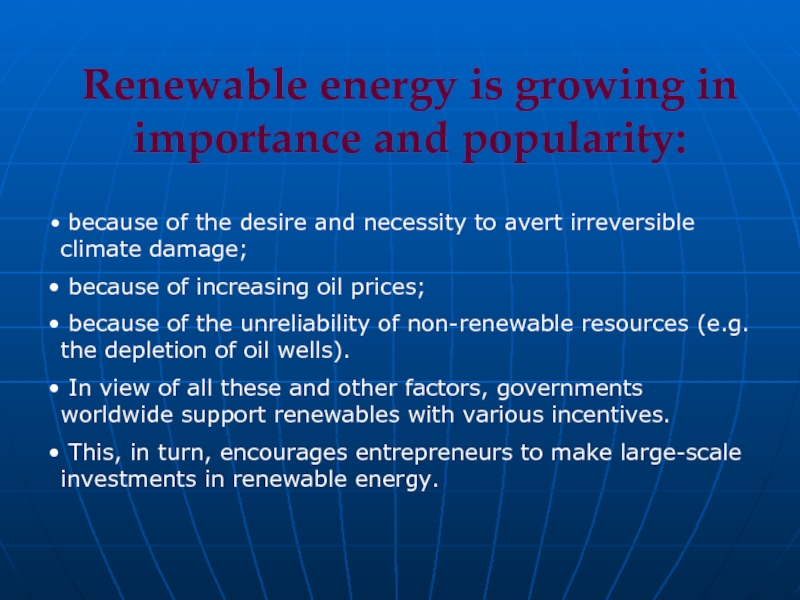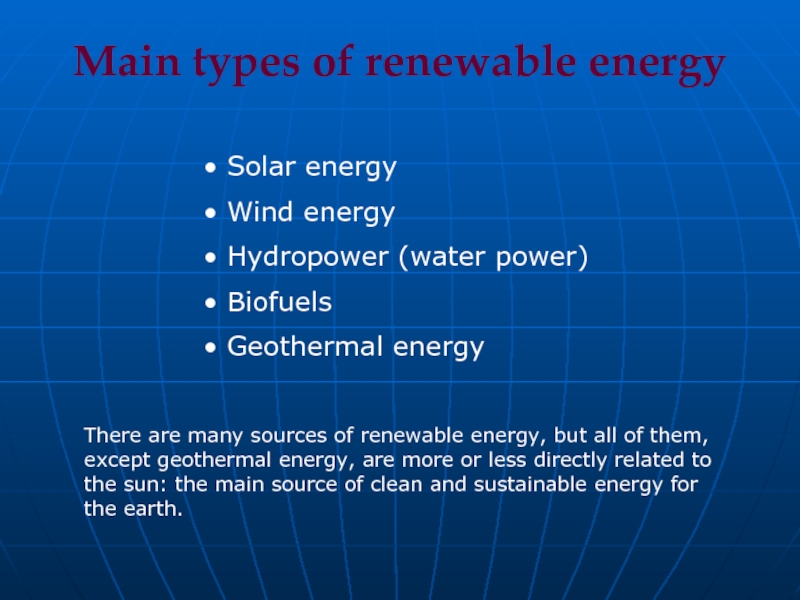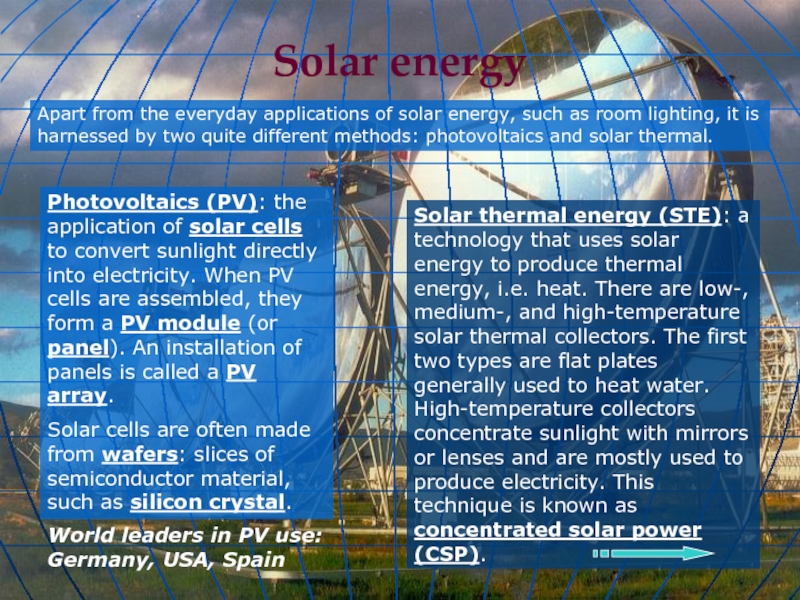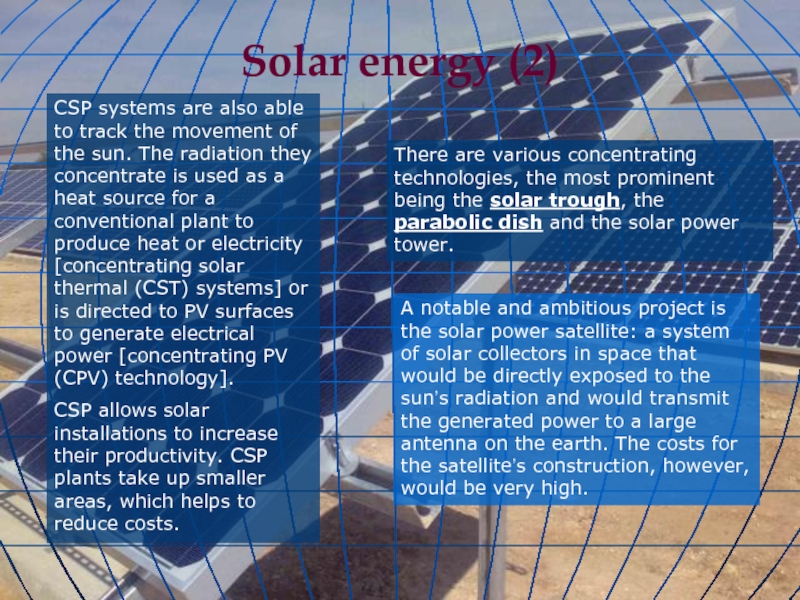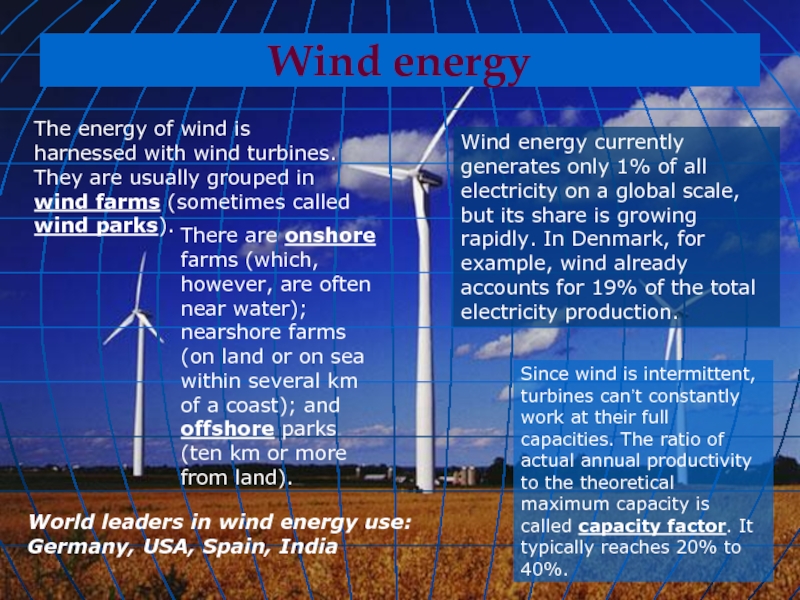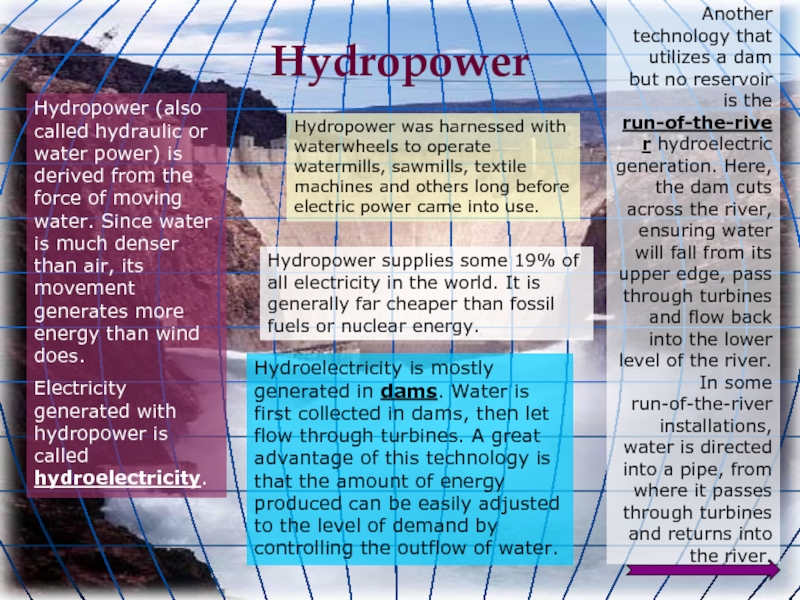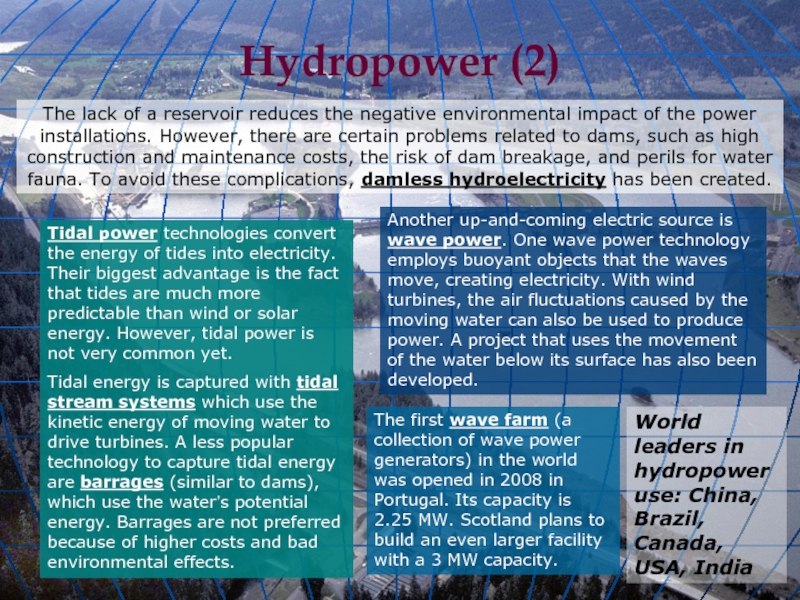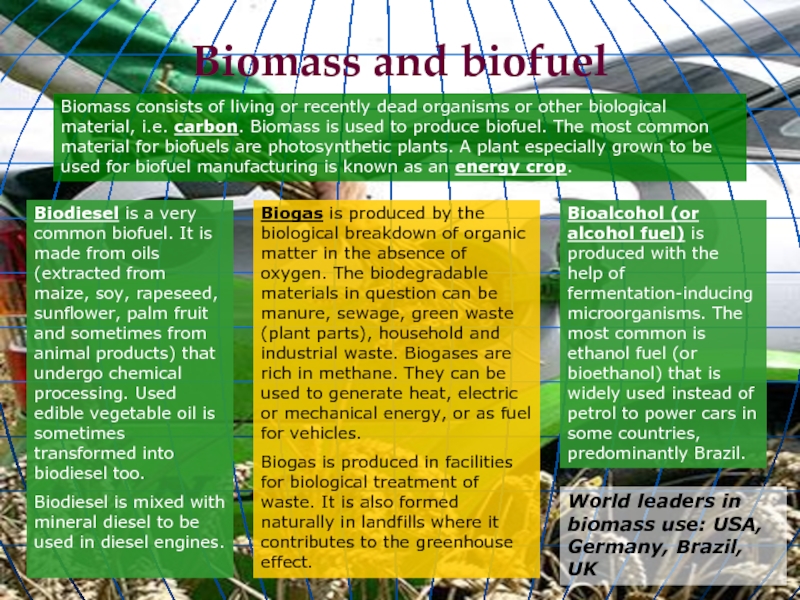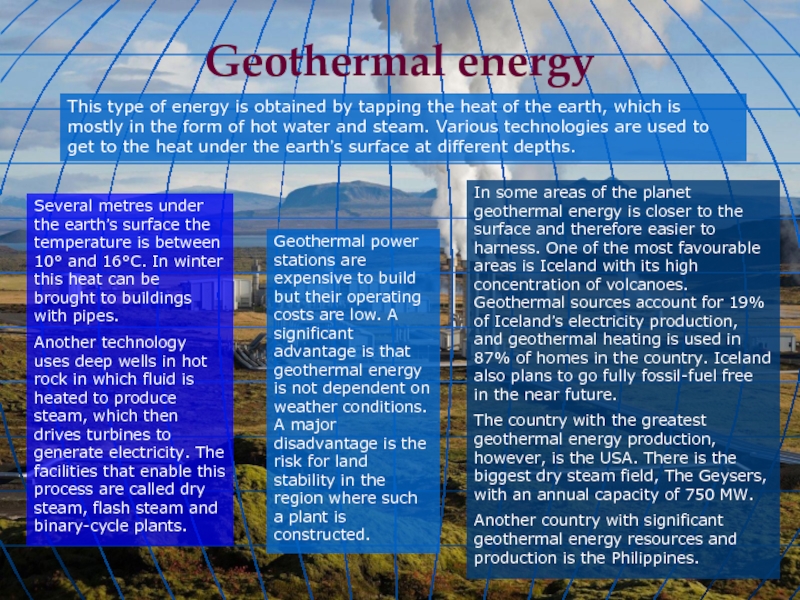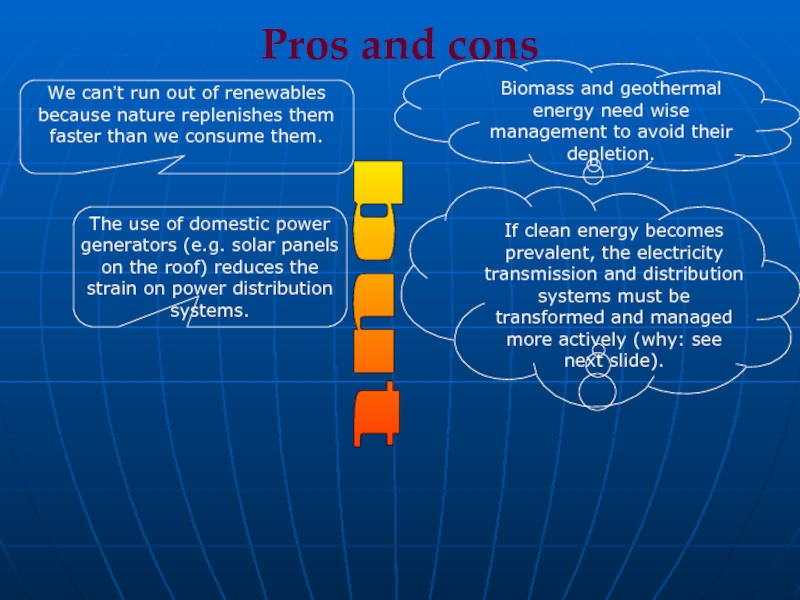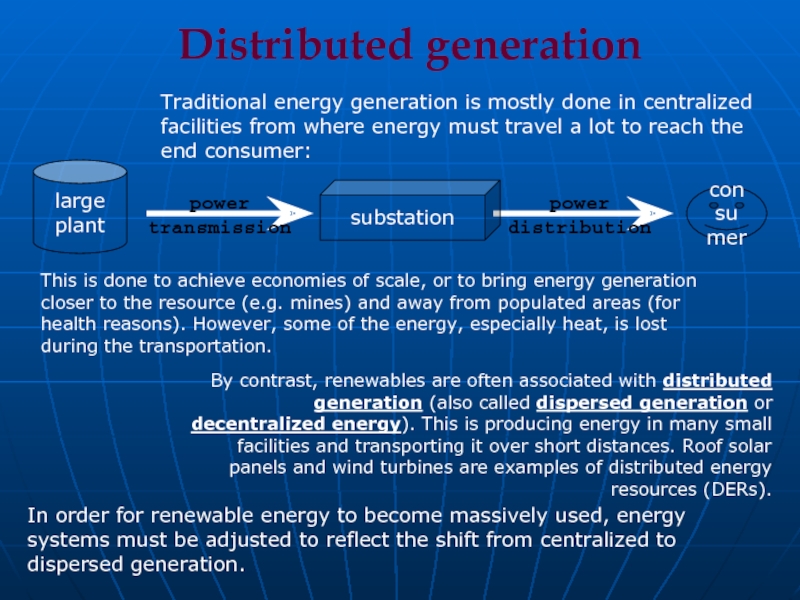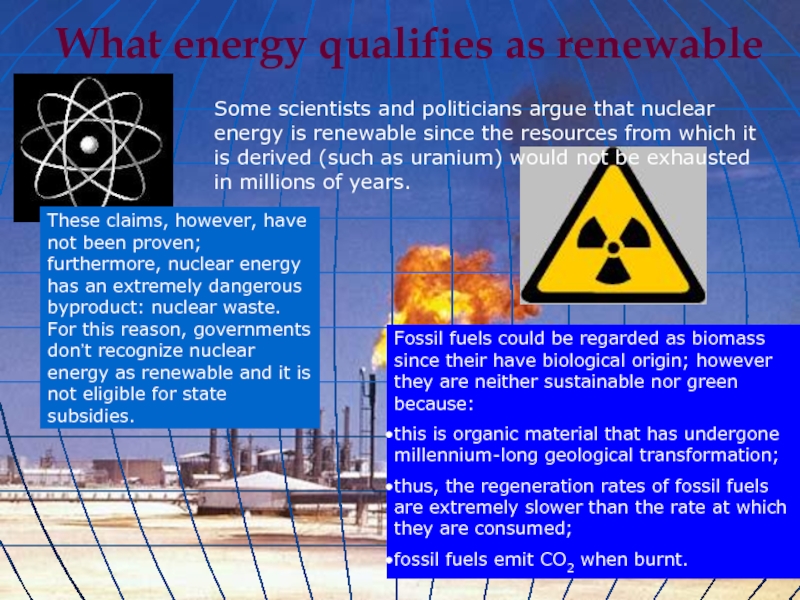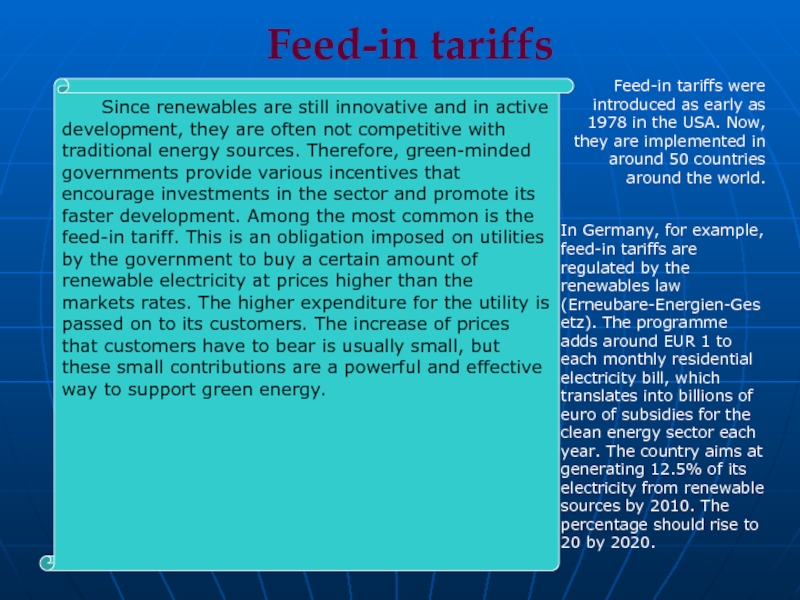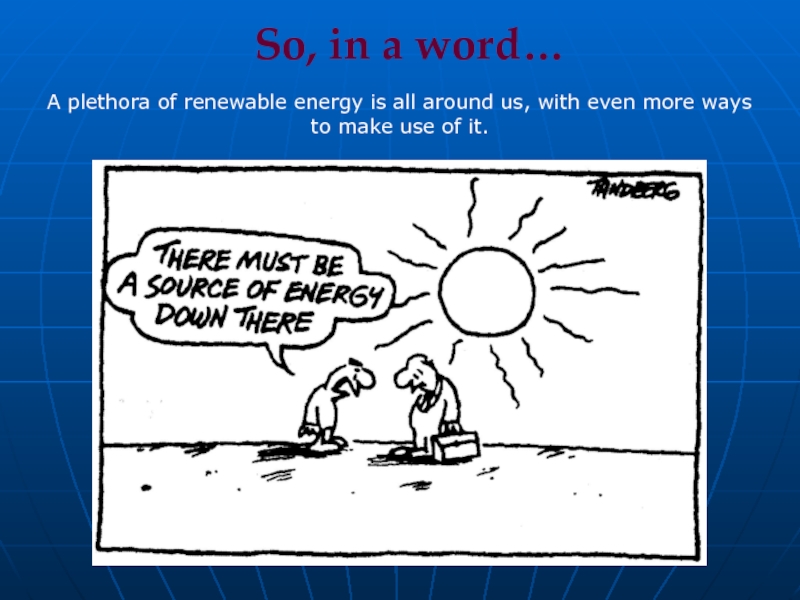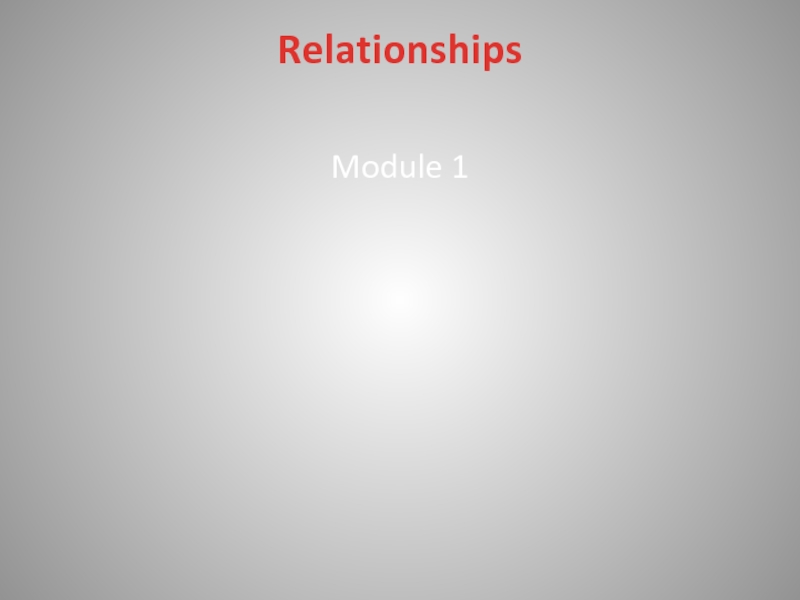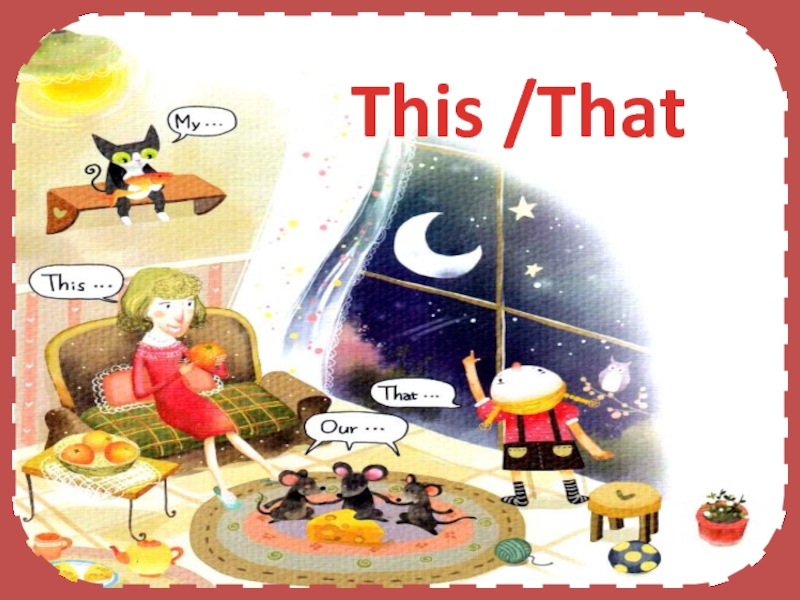- Главная
- Разное
- Дизайн
- Бизнес и предпринимательство
- Аналитика
- Образование
- Развлечения
- Красота и здоровье
- Финансы
- Государство
- Путешествия
- Спорт
- Недвижимость
- Армия
- Графика
- Культурология
- Еда и кулинария
- Лингвистика
- Английский язык
- Астрономия
- Алгебра
- Биология
- География
- Детские презентации
- Информатика
- История
- Литература
- Маркетинг
- Математика
- Медицина
- Менеджмент
- Музыка
- МХК
- Немецкий язык
- ОБЖ
- Обществознание
- Окружающий мир
- Педагогика
- Русский язык
- Технология
- Физика
- Философия
- Химия
- Шаблоны, картинки для презентаций
- Экология
- Экономика
- Юриспруденция
Renewable Energy Sources презентация
Содержание
- 1. Renewable Energy Sources
- 2. These are resources found in nature
- 3. Renewable energy is growing in importance and
- 4. Main types of renewable energy
- 5. Solar energy Apart from the everyday applications
- 6. Solar energy (2) CSP systems are also
- 7. Wind energy The energy of wind is
- 8. Hydropower Hydropower (also called hydraulic or water
- 9. The lack of a reservoir reduces the
- 10. Biomass and biofuel Biomass consists of living
- 11. Geothermal energy This type of energy is
- 12. We can’t run out of renewables
- 13. Traditional energy generation is
- 14. What energy qualifies as renewable Some scientists
- 15. Feed-in tariffs Since renewables are still innovative
- 16. So, in a word… A plethora of
Слайд 1
Renewable Energy Sources
© Stoyan Dimitrov, journalist at AII Data Processing
http://www.slideshare.net/trilby/renewable-energy-sources-presentation?from_action=save
Слайд 2 These are resources found in nature that are self-regenerating:
sunlight
geothermal
tides
wind
biomass
These sources are normally used to produce clean (or green) energy. This production does not lead to climate change and does not involve emission of pollutants.
A related term is sustainable energy: this concept refers to generating energy with an awareness of the future, i.e. in a way that would enable future generations to meet their energy needs too. The concept is related not only to renewables, but also to energy efficiency.
waves
What renewables are
Слайд 3Renewable energy is growing in importance and popularity:
because of the
because of increasing oil prices;
because of the unreliability of non-renewable resources (e.g. the depletion of oil wells).
In view of all these and other factors, governments worldwide support renewables with various incentives.
This, in turn, encourages entrepreneurs to make large-scale investments in renewable energy.
Слайд 4Main types of renewable energy
Solar energy
Wind energy
Hydropower (water
Biofuels
Geothermal energy
There are many sources of renewable energy, but all of them, except geothermal energy, are more or less directly related to the sun: the main source of clean and sustainable energy for the earth.
Слайд 5Solar energy
Apart from the everyday applications of solar energy, such as
Photovoltaics (PV): the application of solar cells to convert sunlight directly into electricity. When PV cells are assembled, they form a PV module (or panel). An installation of panels is called a PV array.
Solar cells are often made from wafers: slices of semiconductor material, such as silicon crystal.
Solar thermal energy (STE): a technology that uses solar energy to produce thermal energy, i.e. heat. There are low-, medium-, and high-temperature solar thermal collectors. The first two types are flat plates generally used to heat water. High-temperature collectors concentrate sunlight with mirrors or lenses and are mostly used to produce electricity. This technique is known as concentrated solar power (CSP).
World leaders in PV use: Germany, USA, Spain
Слайд 6Solar energy (2)
CSP systems are also able to track the movement
CSP allows solar installations to increase their productivity. CSP plants take up smaller areas, which helps to reduce costs.
There are various concentrating technologies, the most prominent being the solar trough, the parabolic dish and the solar power tower.
A notable and ambitious project is the solar power satellite: a system of solar collectors in space that would be directly exposed to the sun’s radiation and would transmit the generated power to a large antenna on the earth. The costs for the satellite’s construction, however, would be very high.
Слайд 7Wind energy
The energy of wind is harnessed with wind turbines. They
There are onshore farms (which, however, are often near water); nearshore farms (on land or on sea within several km of a coast); and offshore parks (ten km or more from land).
Wind energy currently generates only 1% of all electricity on a global scale, but its share is growing rapidly. In Denmark, for example, wind already accounts for 19% of the total electricity production.
Since wind is intermittent, turbines can’t constantly work at their full capacities. The ratio of actual annual productivity to the theoretical maximum capacity is called capacity factor. It typically reaches 20% to 40%.
World leaders in wind energy use: Germany, USA, Spain, India
Слайд 8Hydropower
Hydropower (also called hydraulic or water power) is derived from the
Electricity generated with hydropower is called hydroelectricity.
Hydropower was harnessed with waterwheels to operate watermills, sawmills, textile machines and others long before electric power came into use.
Hydroelectricity is mostly generated in dams. Water is first collected in dams, then let flow through turbines. A great advantage of this technology is that the amount of energy produced can be easily adjusted to the level of demand by controlling the outflow of water.
Hydropower supplies some 19% of all electricity in the world. It is generally far cheaper than fossil fuels or nuclear energy.
Another technology that utilizes a dam but no reservoir is the run-of-the-river hydroelectric generation. Here, the dam cuts across the river, ensuring water will fall from its upper edge, pass through turbines and flow back into the lower level of the river. In some run-of-the-river installations, water is directed into a pipe, from where it passes through turbines and returns into the river.
Слайд 9The lack of a reservoir reduces the negative environmental impact of
Hydropower (2)
World leaders in hydropower use: China, Brazil, Canada, USA, India
Tidal power technologies convert the energy of tides into electricity. Their biggest advantage is the fact that tides are much more predictable than wind or solar energy. However, tidal power is not very common yet.
Tidal energy is captured with tidal stream systems which use the kinetic energy of moving water to drive turbines. A less popular technology to capture tidal energy are barrages (similar to dams), which use the water’s potential energy. Barrages are not preferred because of higher costs and bad environmental effects.
Another up-and-coming electric source is wave power. One wave power technology employs buoyant objects that the waves move, creating electricity. With wind turbines, the air fluctuations caused by the moving water can also be used to produce power. A project that uses the movement of the water below its surface has also been developed.
The first wave farm (a collection of wave power generators) in the world was opened in 2008 in Portugal. Its capacity is 2.25 MW. Scotland plans to build an even larger facility with a 3 MW capacity.
Слайд 10Biomass and biofuel
Biomass consists of living or recently dead organisms or
Biodiesel is a very common biofuel. It is made from oils (extracted from maize, soy, rapeseed, sunflower, palm fruit and sometimes from animal products) that undergo chemical processing. Used edible vegetable oil is sometimes transformed into biodiesel too.
Biodiesel is mixed with mineral diesel to be used in diesel engines.
Biogas is produced by the biological breakdown of organic matter in the absence of oxygen. The biodegradable materials in question can be manure, sewage, green waste (plant parts), household and industrial waste. Biogases are rich in methane. They can be used to generate heat, electric or mechanical energy, or as fuel for vehicles.
Biogas is produced in facilities for biological treatment of waste. It is also formed naturally in landfills where it contributes to the greenhouse effect.
Bioalcohol (or alcohol fuel) is produced with the help of fermentation-inducing microorganisms. The most common is ethanol fuel (or bioethanol) that is widely used instead of petrol to power cars in some countries, predominantly Brazil.
World leaders in biomass use: USA, Germany, Brazil, UK
Слайд 11Geothermal energy
This type of energy is obtained by tapping the heat
Several metres under the earth’s surface the temperature is between 10° and 16°C. In winter this heat can be brought to buildings with pipes.
Another technology uses deep wells in hot rock in which fluid is heated to produce steam, which then drives turbines to generate electricity. The facilities that enable this process are called dry steam, flash steam and binary-cycle plants.
Geothermal power stations are expensive to build but their operating costs are low. A significant advantage is that geothermal energy is not dependent on weather conditions. A major disadvantage is the risk for land stability in the region where such a plant is constructed.
In some areas of the planet geothermal energy is closer to the surface and therefore easier to harness. One of the most favourable areas is Iceland with its high concentration of volcanoes. Geothermal sources account for 19% of Iceland’s electricity production, and geothermal heating is used in 87% of homes in the country. Iceland also plans to go fully fossil-fuel free in the near future.
The country with the greatest geothermal energy production, however, is the USA. There is the biggest dry steam field, The Geysers, with an annual capacity of 750 MW.
Another country with significant geothermal energy resources and production is the Philippines.
Слайд 12
We can’t run out of renewables because nature replenishes them faster
Pros and cons
but
Biomass and geothermal energy need wise management to avoid their depletion.
The use of domestic power generators (e.g. solar panels on the roof) reduces the strain on power distribution systems.
If clean energy becomes prevalent, the electricity transmission and distribution systems must be transformed and managed more actively (why: see next slide).
Renewables are generally not hazardous to the environment.
Some green energy installations take up large pieces of land that can be used to grow crops.
Green electricity is becoming increasingly accessible to the average consumer.
Renewable heat is still expensive and hard to access.
Слайд 13
Traditional energy generation is mostly done in centralized facilities from where
Distributed generation
This is done to achieve economies of scale, or to bring energy generation closer to the resource (e.g. mines) and away from populated areas (for health reasons). However, some of the energy, especially heat, is lost during the transportation.
By contrast, renewables are often associated with distributed generation (also called dispersed generation or decentralized energy). This is producing energy in many small facilities and transporting it over short distances. Roof solar panels and wind turbines are examples of distributed energy resources (DERs).
In order for renewable energy to become massively used, energy systems must be adjusted to reflect the shift from centralized to dispersed generation.
Слайд 14What energy qualifies as renewable
Some scientists and politicians argue that nuclear
These claims, however, have not been proven; furthermore, nuclear energy has an extremely dangerous byproduct: nuclear waste. For this reason, governments don’t recognize nuclear energy as renewable and it is not eligible for state subsidies.
Fossil fuels could be regarded as biomass since their have biological origin; however they are neither sustainable nor green because:
this is organic material that has undergone millennium-long geological transformation;
thus, the regeneration rates of fossil fuels are extremely slower than the rate at which they are consumed;
fossil fuels emit CO2 when burnt.
Слайд 15Feed-in tariffs
Since renewables are still innovative and in active development, they
Feed-in tariffs were introduced as early as 1978 in the USA. Now, they are implemented in around 50 countries around the world.
In Germany, for example, feed-in tariffs are regulated by the renewables law (Erneubare-Energien-Gesetz). The programme adds around EUR 1 to each monthly residential electricity bill, which translates into billions of euro of subsidies for the clean energy sector each year. The country aims at generating 12.5% of its electricity from renewable sources by 2010. The percentage should rise to 20 by 2020.
